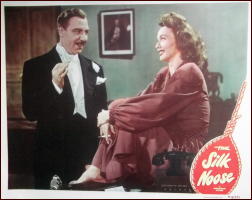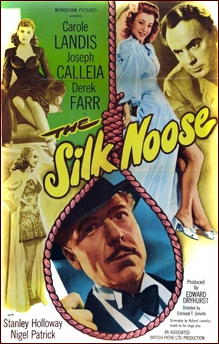Mon 31 Mar 2014
A Movie Review by Daniel Stumpf: NOOSE (1948).
Posted by Steve under Crime Films , Reviews[8] Comments
NOOSE. Pathé Pictures International, UK, 1948. Monogram Pictures, US, 1950, as The Silk Noose. Carole Landis, Joseph Calleia, Derek Farr, Stanley Holloway and Nigel Patrick. Screenplay: Richard Llewellyn. Director: Edmond T. Greville.

An enjoyably lop-sided thing in which disparate elements (nasty gangsters, snappy dialogue, dead women, comedy, torture, slapstick, guilt, laughter) work against each other throughout to produce a film that is actually quite fun to watch.
Carole Landis, in her penultimate film, stars as a plucky gal reporter of the Lois Lane school, working for the fashion department of a great metropolitan (London) newspaper, who tumbles onto the startling fact that there is Vice going on in town and someone’s making money off it.
Dampened by her editor, deprecated by her fiancé and daunted by gangland, our heroine promptly smashes the rackets in about an hour and a half, with the assistance of her ex-commando boyfriend (Derek Farr) a bunch of his mates down at the boxing gymnasium, and the bemused gaze of Stanley Holloway as a crusty cop.
I know it all sounds like pretty standard stuff but Noose is a film that has to be seen to be appreciated. Richard Llewellyn’s (yes, that Richard Llewellyn’s) dialogue carries a pleasant bite, and director Greville moves the action along at a nice clip, pausing long enough to savor a bite of suspenseful unpleasantness or evoke a slice of character, then moving right along.
He does particularly well by Joseph Calleia as a gangland mastermind complete with a nasty personal assassin known as “the Barber†who scuttles about like some sort of loathsome land-bound crab with a perpetual and unsettling leer. And the fact that this nasty toad is played by the comedic Shakespearean trouper Hay Petrie only adds to the cachet.
You may gather from the above that Noose is a grim exercise in Gangland procedure, and you’d be quite right; there are some bits of suspense and sadism that match anything you’re likely to see in American film noir. Imagine my surprise then when the story wraps up in a burst of farcical slapstick so silly one looks around for the Three Stooges to show up. It doesn’t spoil the film by any means, but it does edge it closer to Monty Python than Mickey Spillane.
A few more points that deserve to be outed:
One seldom praises the editing in a film because when it’s really good, editing goes unnoticed. But here it calls attention to itself with brassy charm as editor David Newhouse (who only did one other film) keeps changing scene by cutting from one moving figure to another moving in the same direction, or from one image to its mirror-twin, polishing the flashy narrative even brighter. One notices the editing in Noose and appreciates it.
Then there’s Nigel Patrick as Calleia’s second-in-command, delivering a perfect performance in such a well-written part that at times it quite overbalances the whole film, and no one cares. Words can’t do it justice; you just have to see Patrick strutting about like a wind-up toy barking out staccato tongue-twisters to fall in love with him.
And finally mention must be made of an actress in another throw-away part, Carol van Derman as a momentary object of Calliea’s attentions. She spends several minutes toward the end of this film stepping about in her step-ins, and she’s rather good at it.

April 1st, 2014 at 1:41 pm
In my opinion, humble as it is, Carole Landis never had the career she should have had, and she died far far too soon.
April 1st, 2014 at 3:13 pm
Yes, in spades.
April 1st, 2014 at 5:20 pm
Ditto on Landis.
I may have to see this one. It’s hard to believe the author of How Green Was My Valley and None But the Lonely Heart wrote this even though he did several spy novels (good ones about Edmond Trothe) late in his career.
British crime films from this era often seemed a little schizophrenic touching on noir, gangland, comedy, spy, and Peter Cheyney elements. But some — like this one — are fun to watch.
April 2nd, 2014 at 10:01 pm
Upon reflection I began checking Carole out. There is quite a site run by her family — Carole Landis Hollywood Legend, mostly relative to her death and Murder…? We should try to solve this case.
April 2nd, 2014 at 11:00 pm
Barry
Here’s the link: http://carolelandisofficial.blogspot.com/
It’s surprising frank. Not only does it cover her death in detail, but it includes a list of many of her lovers, of whom there apparently quite a few.
Re her death. I have always suspected a coverup of some kind. Still do.
April 3rd, 2014 at 12:26 am
That ‘s what I mean. There is a book in it. Something…I have yet to hear a nice word spoken about Rex Harrison. The Incomparable Rex by Patrick Garland was on remainder so I bought several and sent two copies to my father, who was great friends with Milo O’Shea, second copy for Milo. The book destroys Rex, but Milo was even better. Almost violent in his reaction to the man.
April 3rd, 2014 at 6:19 am
Wasn’t it Harrison’s wife, Lili Palmer, who asked, “What does one wear to the funeral of one’s husband’s mistress?”
April 3rd, 2014 at 5:28 pm
A handsome actor who is a rat? I’m shocked.
Re Landis, it is one of the great Hollywood mysteries, but from an era when the studios could still bury anything they wanted. Once in a while you get a solution that is more than speculation like King Vidor’s book on William Desmond Taylor, but in general they just end up more mysterious,